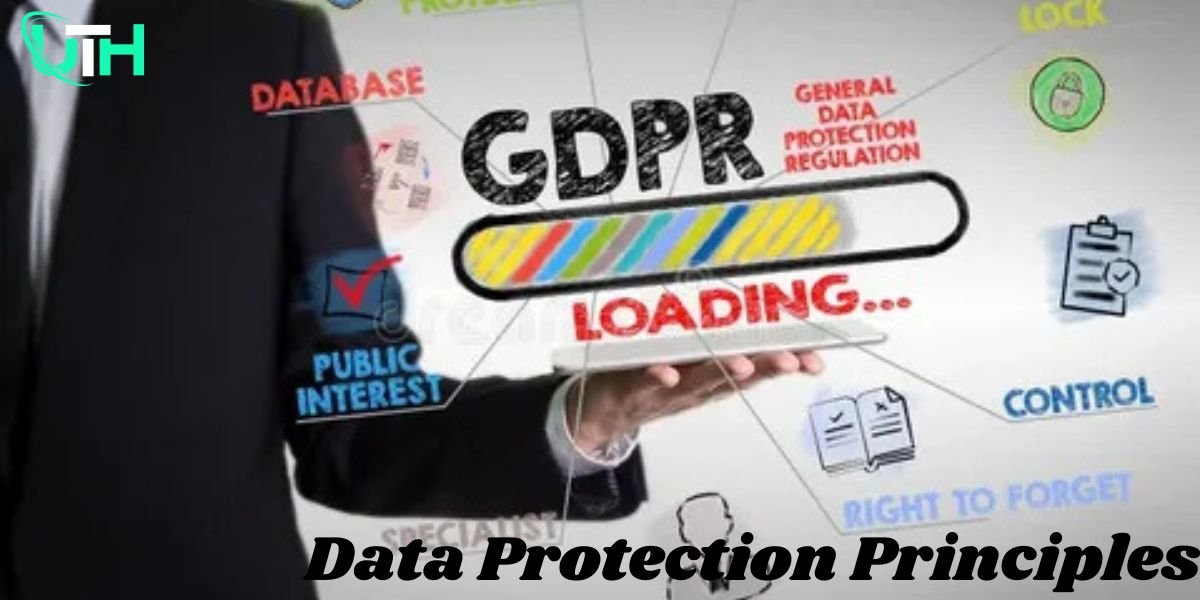Cybersecurity
A Guide to Data Protection Principles: Protect Your Data Like a Pro

Key points
- The UK GDPR establishes seven fundamental guidelines.
- Lawfulness, fairness, and transparency
- Purpose limitation
- Data minimization
- Accuracy
- Storage limitation
- Integrity and confidentiality (security)
- Accountability
- Your approach to handling personal data should be based on these principles.
Why are the GDPR Principles important?
The UK GDPR is based on these principles. The law outlines these principles at its very beginning, serving as the foundation for all subsequent provisions. There are very few exceptions, as they express the spirit of the overall data protection policy rather than serve as strict guidelines.
Therefore, keeping to the spirit of these core principles is an important element of effective data protection procedures. Compliance with UK GDPR rules is also required.
You might be subject to hefty fines if you violate the principles. According to Article 83(5)(a), violations of the fundamental guidelines for handling personal data carry the worst administrative penalties. A fine of up to £17.5 million or 4% of your whole yearly global revenue, whichever is bigger, might result from this.
Which organisation is responsible for enforcing data protection law in the UK?
Empowering Your Digital Strategy With Chatbots
What are the 7 principles of the GDPR?
Simply put, seven core privacy principles form the foundation of the GDPR’s rules for data processing. You will find it easier to understand the rules and regulations if you are familiar with these seven concepts.
1. Lawfulness, fairness, and transparency
You should always have a valid justification before processing personal data. GDPR refers to this idea as lawfulness. We can process data for the following purposes:
- You have permission to do so from the user.
- To fulfill a contract, you have to achieve it.
- It’s necessary to fulfill a legal obligation.
- for the defense of a natural person’s essential interests.
- Everyone benefits from this public endeavor.
- You can demonstrate that your legitimate interest is unaffected by the rights and interests of the data subject.
Fairness closely relates to lawfulness and the definition of GDPR. It implies that you shouldn’t intentionally hide details regarding the nature or goal of your data collection. In other words, people wouldn’t be surprised how you used their data. Being fair involves not misusing or mishandling the information you get.
Fairness and transparency have no separation. Transparency is defined as being open, honest, and transparent with data subjects about your identity as well as the reasons and methods by which you process their data. By following it, you treat your data subjects fairly.
2. Purpose limitation
This principle states that you should only process personal data for its intended purpose. To put it another way, you shouldn’t utilize your personal information again.
Purpose limitation in our example
Our example implies that you should only use newsletter data for the purposes you specify. If you specify in your newsletter consent that you are keeping your subscribers’ IP addresses to record when and how you obtained their consent (as required by the GDPR), then you cannot use their IP addresses to send them geographically targeted, customized content, such as product recommendations. This would involve using their personal information for a different purpose.
However, you may be able to use their personal information to send out targeted emails if you have declared, for example, that you collect their IP addresses in order to send out the newsletter and pertinent material. However, there are extremely rigorous prerequisites for this, so please remember the term “might.”
Your team behaves like front-line employees while handling personal data. You have to make sure they don’t mistakenly reuse data in a way that isn’t compliant. Training your staff and educating them on privacy concerns is the best method to convey this.
3. Data minimization
There is an urge for all of us to collect data. Although we rarely use them, we keep them because they’re useful. The third GDPR principle states that we should not keep unnecessary data.
This rule suggests we shouldn’t collect more personal information than is necessary to provide the service. In other words, just collect and handle the precise quantity of data required.
Data minimization in our example
The example suggests that you should only gather the personal information necessary for sending the newsletter. The subscribers’ names and email addresses, for example, may be required, but their work titles are not. Perhaps this information is just “nice to have,” and you may not even utilize it.
However, you may benefit from understanding how to apply data minimization in a number of ways. In addition to getting you closer to GDPR compliance, it will reduce the effect of a potential data breach.
4. Accuracy
You are responsible for making sure the information you gather and maintain is accurate. Establish mechanisms to update, remove, or rectify incoming data that is inaccurate or lacking. Moreover, plan regular audits to verify the accuracy and cleanliness of the data stored.
Accuracy in our example
For clarity, let me return to our example. Let’s take an example where a subscriber worked at business X and signed up for your newsletter using their work email address. Business X’s email address will no longer function if this individual switches jobs and starts working for Business Y. You no longer have the correct information about this user.
Offering a link in your newsletter for your subscribers to update their email addresses might be a “reasonable measure” in this situation. The individual can easily update their personal information when they learn of their impending employment change.
An email marketing system or CRM system that tracks email addresses and responds immediately when you send out your newsletter is another option. Often, the employer will display an automated response, signaling the employee’s departure from the organization.
Others, like vacationers, may create automated responses. To check for subscribers with incorrect email addresses, you should periodically review these automated responses.
You should update or remove inaccurate data, as its handling is not justified.
5. Storage limitations
When you no longer require personal information, you should delete it. Generally, you should discard personal information that no longer serves its original purpose. The data minimization concept bears a striking resemblance to this one, as many organizations believe that part of it entails discarding outdated data.
By putting in place a procedure for safely eliminating data, you can make sure that information that is no longer required is really deleted and isn’t left on a device or in the cloud, where it can pose a security risk.
Storage limitations in our example
In our case, storage limitations may arise due to the removal of data from subscribers who opt out of your newsletter. Similarly, if your company decides to cease sending newsletters, you must remove the personal information of your subscribers. Your company collects subscribers’ personal information to send newsletters; if that purpose no longer exists, stop using it.
In certain situations, it may be relevant to remove personal data and utilize it for historical or statistical analysis or to retain the data for some time after the original purpose has expired. However, remember that these situations are exceptions, not norms, and require careful evaluation.
6. Integrity and confidentiality
The GDPR demands that you protect the confidentiality and integrity of the data you gather, which is equivalent to protecting it from attacks both inside and outside your company. Preparation and proactive diligence are necessary for this. We must protect data from accidental loss, destruction, or damage, as well as from unlawful or unauthorized processing.
7. Accountability
A company may claim to comply with all regulations without actually doing so, according to the GDPR authorities.
They thus demand a certain amount of accountability: As evidence of your commitment to the data processing principles, you must have the proper procedures and documentation in place. Supervisory authorities may request this evidence at any moment. Here, documentation is crucial. This creates an audit trail that you and the authorities can use to prove accountability.
Include the 7 principles of GDPR in your business operations.
The 7 Guidelines of GDPR convey the core concepts and philosophy of best practices for data processing. Furthermore, the GDPR lays forth duties for data controllers and processors that support each of the principles.
These 7 principles guide all business processes and processing activities, from the design phase to the full data processing lifecycle, rather than serving as a component of the operational jigsaw. Implementing privacy by design and default is the best way to do this.
See our in-depth introduction to GDPR compliance to understand how this operates and to discover more about the GDPR’s tenets. It serves as a road map for fully integrating and putting the GDPR principles into practice inside your privacy program.
Conclusion
In conclusion, the GDPR’s complex wording and detailed explanations can occasionally make it difficult to grasp. The purpose of this tutorial was to serve as a starting point for novices. I hope this article was enjoyable to read and that the knowledge it provides will help you in your compliance job.
Read more:
How to Choose the Right VPS Hosting in Germany for Forex Trading
What is Spear Phishing and How You Can Identify This Scam?
PayPal Phishing Scam: Don’t Get Hooked! Learn How to Stay Safe
Apple ID phishing scam targets users with fake suspension emails
-

 Phishing attack8 months ago
Phishing attack8 months agoWhat is Spear Phishing and How You Can Identify This Scam?
-

 Social engineering attack10 months ago
Social engineering attack10 months agoBaiting Attacks Explained: A Closer Look at Cyber Threat Tactics
-

 Social engineering attack8 months ago
Social engineering attack8 months agoWhat are Social Engineering Attacks – A Complete Guide to Cyberattacks Prevention
-

 Social engineering attack9 months ago
Social engineering attack9 months agoSpear Phishing Attack: A Targeted Cyber Threat
-

 Social engineering attack10 months ago
Social engineering attack10 months agoWhat is spear phishing attack? A detailed guide
-

 Social engineering attack10 months ago
Social engineering attack10 months agoWhat is spear phishing in cyber security?
-

 Phishing attack4 months ago
Phishing attack4 months agoWhy is Phishing Still a Major Cyber Threat? Everything You Need to Know
-

 Phishing attack8 months ago
Phishing attack8 months agoWhat Are Phishing Emails? A guide for you




















